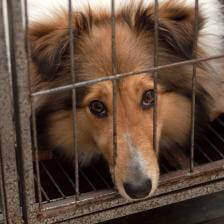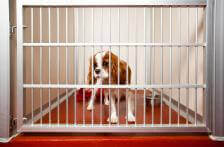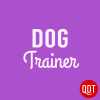Puppy Mill Rescue Dogs
A puppy mill dog may have spent her entire life in a cage before being rescued. In a frightening new world, how can you help her adjust and learn to feel safe?
Jolanta Benal, CPDT-KA, CBCC-KA
Listen
Puppy Mill Rescue Dogs

“Three months ago we adopted a 9-year-old Sheltie from a rescue group. She spent most of her life in a puppy mill at a breeder. The dog is terrified of all people. She runs and hides under furniture. She still poops in the house at least two times a week, even though she is walked and let out several times a day. She reminds me of a wild deer. When we tried crate training, she had diarrhea and sat in it. I am desperately frustrated.” Help!
This week, puppy mill breeding dogs, and how to cope with the challenge of rehabilitating them.
.
On the Dog Trainer podcast, I’ve emphasized how important it is for young puppies to enjoy wide, pleasant experiences of the world. Up until the age of about 12 weeks, puppies are developmentally prepared to learn about what’s normal and commonplace in the world – from people and animals to surfaces that dogs walk on and sounds they might hear.
Life in a Puppy Mill
Now picture the normal and commonplace world of a puppy who grows up in a factory for making more dogs. All she sees, week in and year out, is the cage or kennel she lives in. It’s crammed with other dogs, some of whom are sick or injured. No one takes her for walks. There’s no place comfortable to sleep. Human contact? What a joke – someone comes and provides food and water, but not friendship or comfort or play. From time to time maybe the cage gets hosed down.
As horrible as all that is, it’s familiar. Not only is it familiar, but what’s unfamiliar is cause for fear. That’s why we socialize puppies so carefully in the first place. For the ex-puppy mill dog, your gently extended hand, the sound of the coffeemaker, a door swinging open, the wide-open space of your backyard, a person with a beard, a car ride, the neighbor’s cat: all of these are new and alien, and probably frightening.
And then there’s housetraining. Remember that a dog who grew to adulthood in a puppy mill may never have been out of his cage or kennel before being rescued. Usually, when we housetrain a puppy, we leverage dogs’ preference not to eliminate when they can’t move away from their urine and feces. We might crate a puppy between toilet breaks, for example, to help him learn to hold on little by little. But puppy mill dogs have no choice – they have to urinate and defecate in their pen or cage.
Result: The inhibition that helps us housetrain our puppies is long gone. Like Ursula’s Sheltie, your puppy mill rescue may eliminate in his crate and then just sit in his waste.
To rehabilitate an ex-puppy mill dog, you’ll need patience, consistency, and some healthy realism. You’ll also probably need more support and guidance than you can get from a podcast episode, too. Hopefully, the rescue group you got your dog from has your back. A great online resource is Debbie Jacobs’ website, FearfulDogs.com. Best Friends Animal Society provides an excellent short guide. And here come 7 tips to get you started:
Tip #1: Give Your Dog a Hiding Place

Tip #2: Let Your Dog Set the Pace
The surest way to ease fear is to let the dog – or any animal, including a human – control her exposure to whatever scares her. Little by little, she can relax enough to investigate them on her own without being overwhelmed. You can encourage, but never push.
Many websites about puppy mill dogs advise feeding them by hand. I wouldn’t jump to do this – it may present your dog with the ugly choice between going hungry or eating while terrified. If she’ll take food comfortably from your hand, great. But if not, then just hang in the same room with her at first. You can gradually decrease the distance between you over days and weeks. Have I mentioned patience?
Tip #3: Feed Regular Meals Instead of Leaving Food in the Bowl All Day
This is housetraining advice! If you know when your dog ate, then you have a good idea of when she’s likely to eliminate. The better you can time toilet breaks, the better your dog’s chances of learning to hold it till she gets outdoors.
While we’re on the subject of housetraining: Treat your puppy mill rescue like a tiny puppy – give her many more toilet breaks than a normal adult dog needs, and supervise her carefully in between. But unlike a new puppy, your dog may have had years of practice eliminating indoors or in her kennel. Remember it takes much longer to undo a problem habit than it takes to learn a good habit in the first place. Once again: patience.
Tip #4: Keep Your Dog on Leash, Even in Your Backyard
A puppy mill dog who’s had no chance to learn that humans can be safe and friendly will not come when you call her. If you chase her, she will almost certainly run away. A loud sound that would startle another dog may panic her. Until she’s comfortable in her new environment, always take her outside on leash and be sure her collar or harness is secure. That goes even in your own fenced backyard!
If possible, create an “airlock,” with at least two closed gates or doors between your dog and the world outside. If you can’t make an airlock, consider having her wear a light leash inside as well, so someone can hold her as people go in and out. (Why a leash? Because she may be afraid to let you hold her by her collar or in your arms.)
Tip #5: Be Predictable

Tip #6: Use Rewards, and Plenty of Them
Reward-based training is best for all animals – it not only teaches them the behaviors you want, but also builds their confidence and their trust in you. Yes, most normal dogs will bounce back from punishments, but your puppy mill dog’s life experience has already strained her to the hilt. Work with a good trainer if you aren’t already familiar with how reward-based training works.
Tip #7: Already Have a Confident, Friendly Dog at Home
Alas, you can’t do this one retrospectively. But if you already have a relaxed, confident dog at home, you’re in luck. Most of a puppy mill dog’s social experience involves other dogs, and dogs who are social partners will often take cues from each other: Is that person scary? What the heck was that sound? Your well-adjusted dog can help your puppy mill rescue learn to navigate the world.
As always, you can write to me at dogtrainer@quickanddirtytips.comcreate new email. I get so many questions that I can’t respond individually, but check out past episodes – I might already have answered yours, especially if it’s about housetraining, humping, or aggression. And please visit me on Facebook, where I’m The Dog Trainer.
Did you know that Quick and Dirty Tips has a brand new show? The Savvy Psychologist is now in session. Dr. Ellen Hendriksen takes the mystery out of psychology and reveals tips and techniques you can use today to become happier, relaxed, and more importantly, yourself. Make sure to check out her new show at quickanddirtytips.com/savvy-psychologist.

